This tactical analysis will look at Fiorentina, unbeaten in their last four games traveled to Rome to face Simeone Inzaghi’s Lazio side who needed a positive result to close the gap on Juventus at the top of Serie A back to 4 points after their defeat to Atalanta earlier in the week. That defeat halted a run of 4 straight wins for Inzaghi’s side and defeat at home to mid-table Fiorentina would surely all but hand the title to Juventus after their crushing defeat of Lecce this weekend.
Fiorentina meanwhile, are the safest of all the sides in the bottom 8 but while they sit in 13th coming into the game they likely need a minimum of 6 points to help them breathe much easier through the final run for home.
This tactical analysis will look into the tactics used by both teams as they searched for 3 points for their different reasons.
Fiorentina sit considerably behind their xPoint total of thirty-eight with their thirty-one points right now and if they continue to underperform things below them could change quickly if they are not careful. That would rely obviously on the teams around them picking up points but a relegation battle does funny things to teams.
The last 10 games between the sides have produced 8 wins for Lazio and 2 for Fiorentina, this tactical analysis will look at how Lazio continued their dominance in the head-to-head and whether Fiorentina can be considered unlucky not to take something from the game.
Team News
Both teams stuck to what they know so well in terms of shape and system. Inzaghi, with the tight turnaround from the Atalanta game was expected to change some personnel for this match however, with 5 players, including Lucas Leiva missing through injury he didn’t perhaps have the depth he would have liked. Giuseppe Iachini had four players unavailable through injury and suspension, the loss of Federico Chiesa is a big blow for Fiorentina given his quality performances through the season to date.
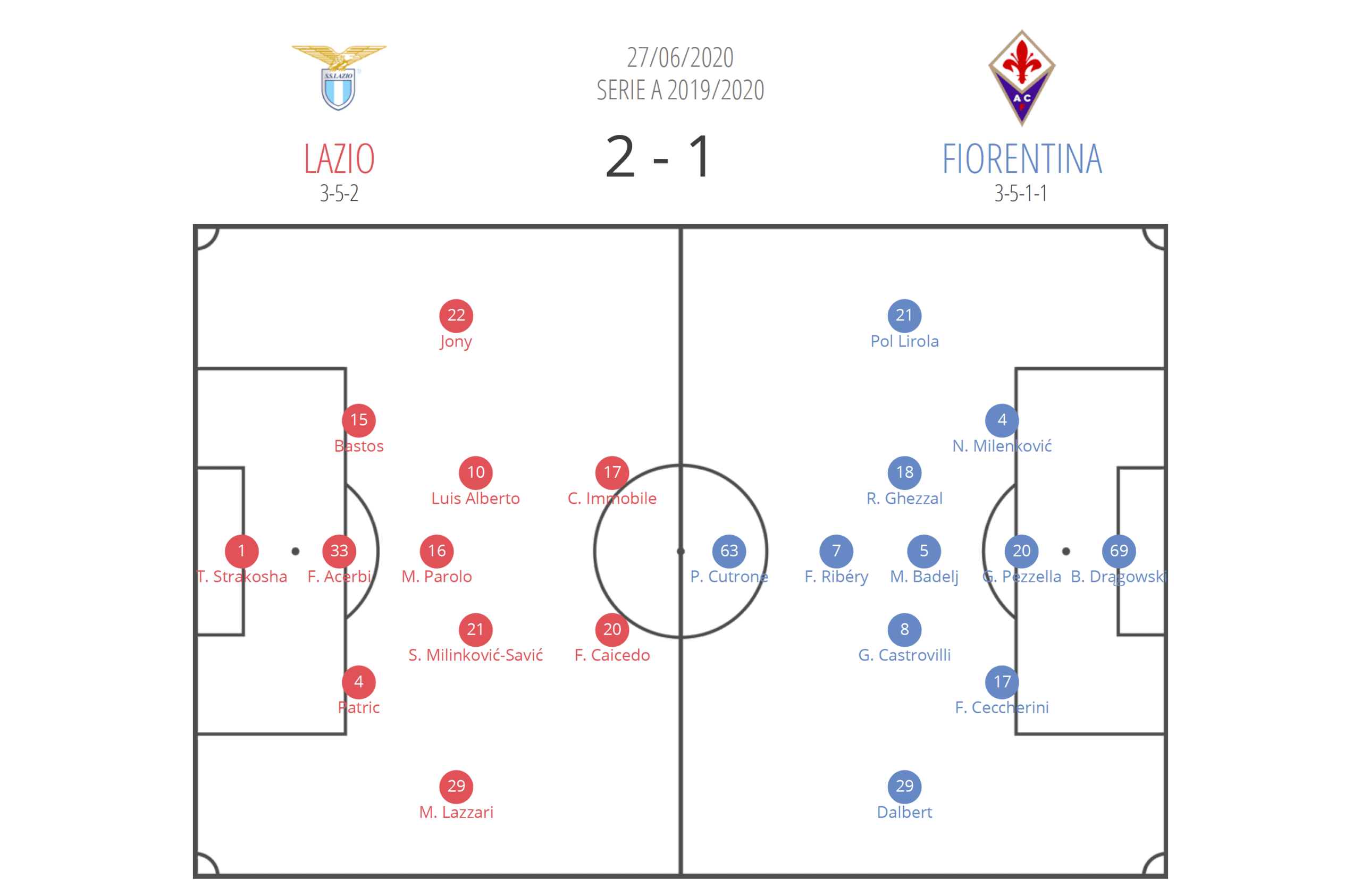
Both teams once again stuck rigidly to their shape and style for this contest which resulted in a real 1v1 battle across the pitch. Inzaghi has used his 3-5-2 in 90% of Lazio’s games and this match was no different. Bastos came into the side after playing from the bench at Atalanta on the left of the back-three to partner Francesco Acerbi and Patric. Marco Parolo again anchored the midfield behind Luis Alberto and Sergej Milinkovic-Savic while the league’s top scorer Ciro Immobile was partnered up top by Felipe Caicedo in that well-travelled partnership.
For Fiorentina, they operated with more of a midfield box, a variation of the 3-5-2 that Lachini has used throughout the season so far. Patrick Cutrone led the line on his own with Franck Ribery and Rachid Ghezzal supporting in behind in the double #10 positions. Gaetano Castrovilli and Milan Badelj completed the midfield box. Dalbert continued at left wingback as he did against Brescia, while the back three that finished that game, started this one.
Game Overview
You can choose to focus on the referee and VAR being the difference in a tight game. Indeed the penalty decision for Lazio in the 67th minute enabled Immobile to add to his tally for the season and draw his team level. Up until that point, Franck Ribery’s wonderful solo effort in the 25th minute had been the difference. It was a game of longer shooting efforts and set pieces causing some threat to each goal. Lazio had a big chance from a wide free-kick as early as the 6th minute when Caicedo headed over unmarked and in fact barring the two goals all the other chances Lazio created were from set-pieces.
The game also hinged on some brilliant individual play from Luis Alberto when it was really needed. Lazio pushed hard for Immobile’s equaliser and even harder for a winner to close the gap on Juventus again. Alberto’s 82nd-minute strike proved to be the winner in a game that offered some fascinating tactical battles within the game and this analysis focus on some of these rather than one particular moment in the game.
Tactical Overview
The first twenty-five minutes up until Ribery’s brilliant opening goal was a fascinating tactical battle with little subtle variations of the same system creating different problems for both teams. In this tactical analysis, we will look at some of the key tactics used by both sides and how both teams tried to exploit one key area within those two slightly different systems.
The use of the wingbacks
In the 3-5-2 system, the most vulnerable areas of the pitch for the team is the space in front or behind their wingback. Unless teams defending in a block have double units in those wide areas many battles can be won or lost here. In a game where there is a genuine match up of system like this one, whichever wingback can either dominate or be dominated is always a good starting point.
Both sides used their wide players in different ways for different needs. Fiorentina, positioned their wingbacks lower and flatter in relation to their back-three, while Lazio pushed their wingbacks much higher for a different reason. We will explore both of those reasons now.
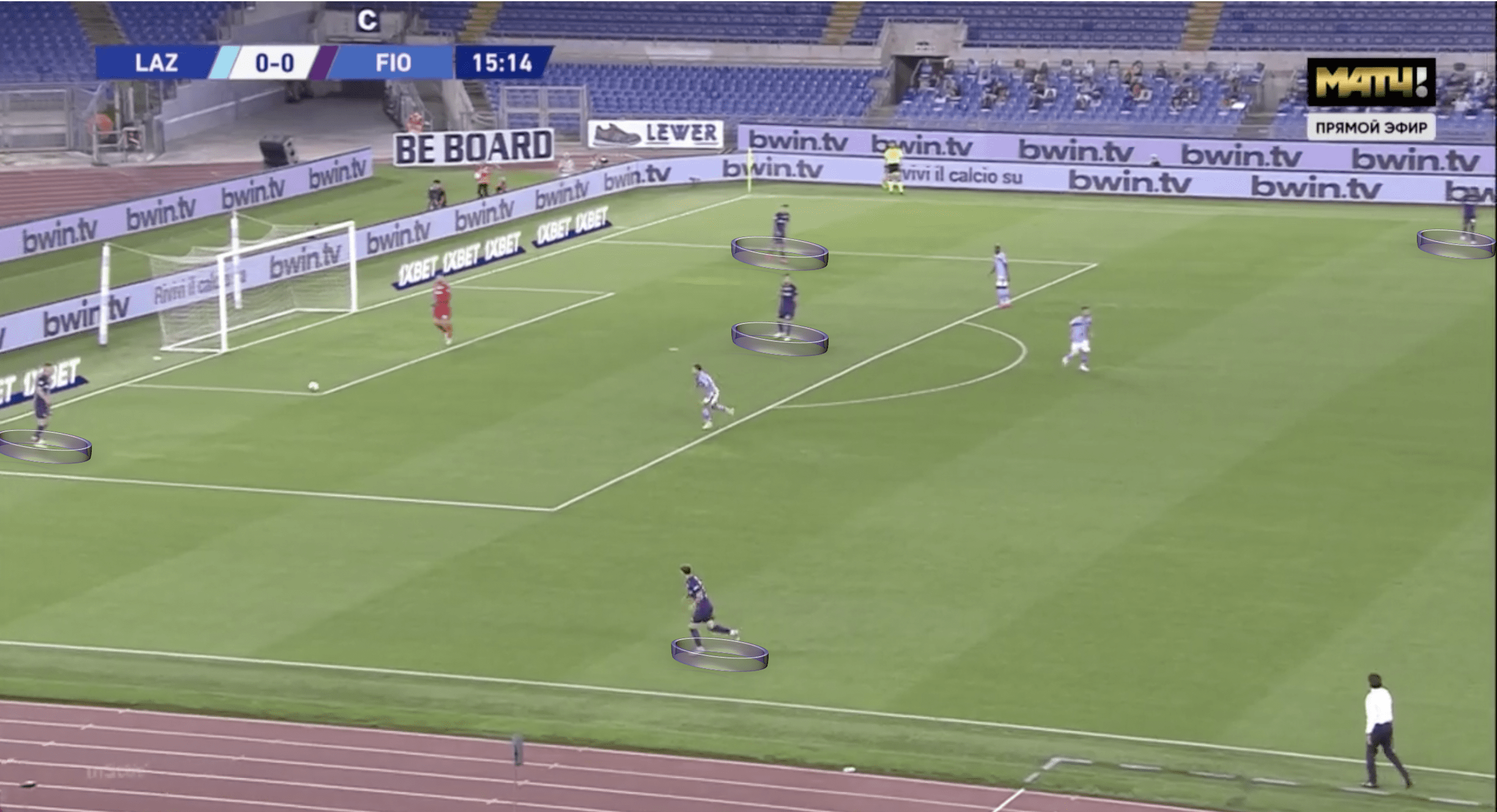
Here, Fiorentina in possession you can see a desire for Lazio to limit build-up play. The depth created by the Fiorentina back-three invites pressure and increases the distance between lines from Lazio unless the whole team commits to the press.
This is because Fiorentina’s objective is to find the double #10 of Ribery and Ghezzal the ball, between lines in central positions to dominate the space around the Lazio #6 Parolo. If they can do that it will force one of the back-three to jump out of the line, create space in behind or give them dominance in front. See the positions of the wingbacks and how flat they are to also encourage pressure from Lazio’s wingbacks. The danger here is that if Lazio can cover the Fiorentina back 5 with minimal numbers they have a huge advantage to pin in Fiorentina against their own box. It would then allow their wingbacks to move higher up the pitch and become more influential with the ball as well as offering the obvious threat of the fast counter towards goal.
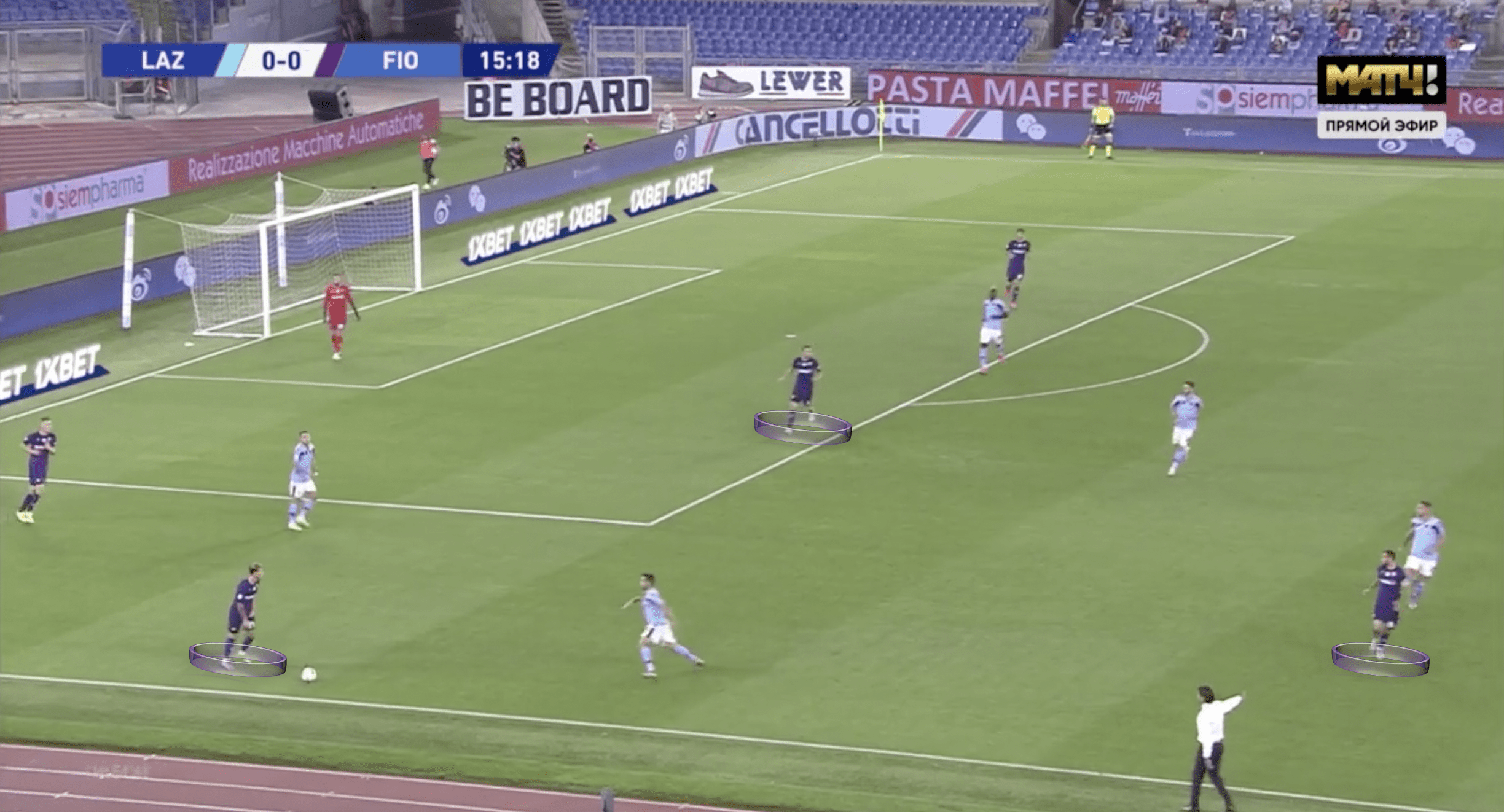
You will see Lazio try to do this here. The key men here for Fiorentina are now the centre-back, Milenkovic who now operates as a #6 to support beside the ball and the ball side #6 Castrovilli who offers support beyond the ball to help progress forwards. Lazio, defending 5v5 here have a chance to recover the ball and counter especially as Fiorentina look to try and find their double #10’s in between lines.
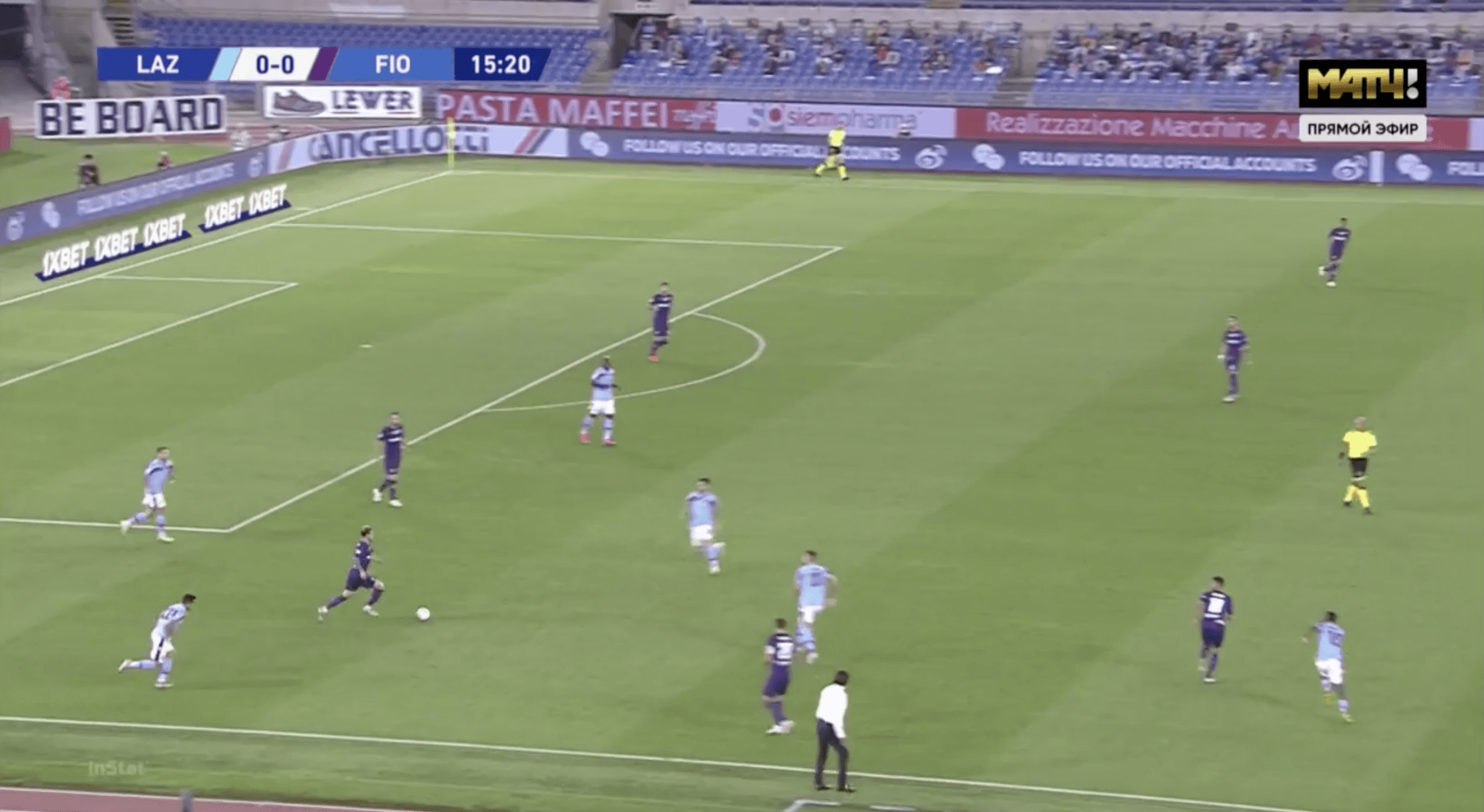
The problem now in this image for Lazio is the man on man system has been broken by the Fiorentina wingback. His drive with the ball attracts two extra players to the ball in this moment, now Fiorentina have a weakside overload but also have options on the ball side created by this drive attracting pressure.
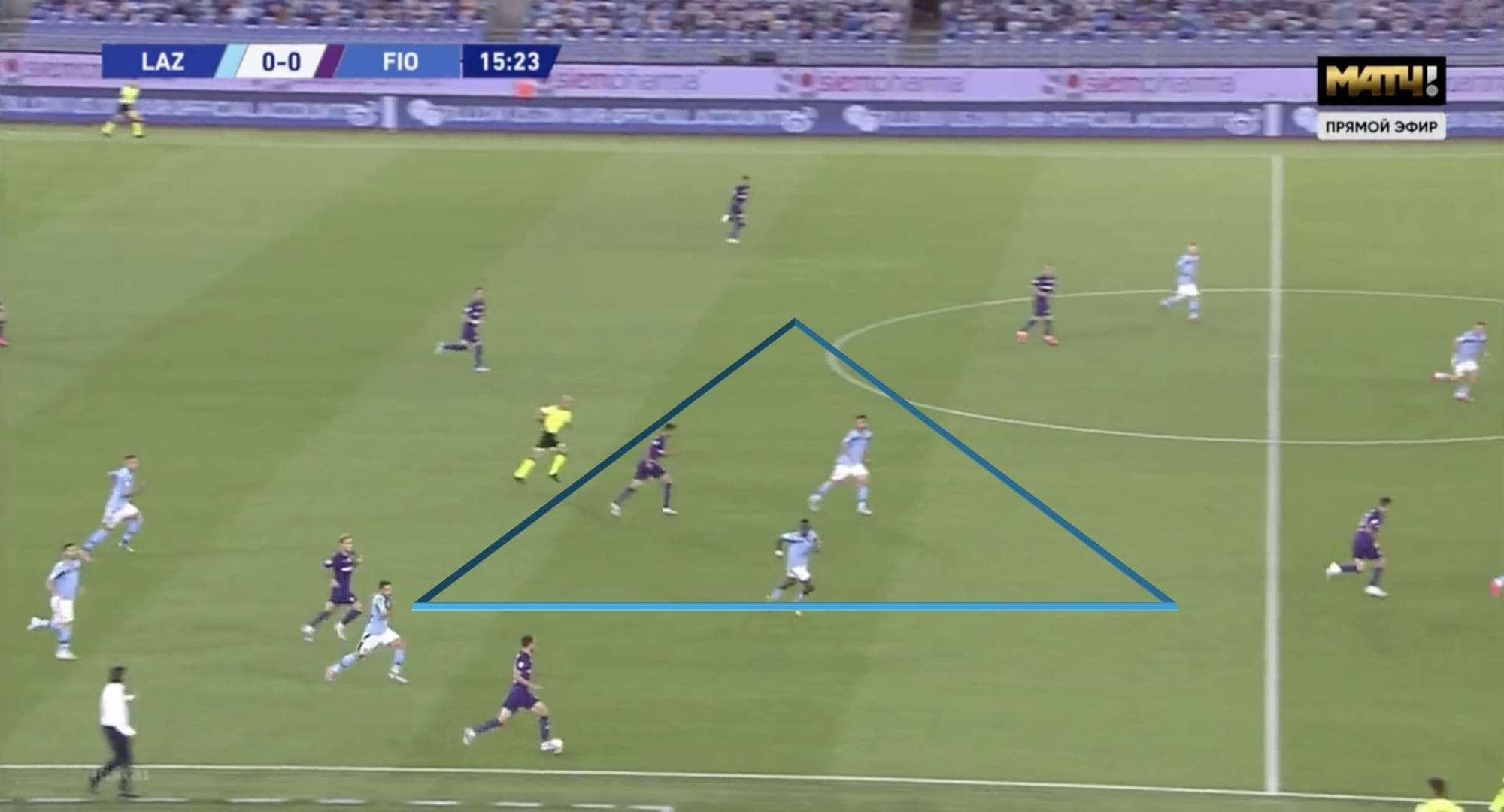
Once he is pressed by the midfield player the wingback quickly finds the free man Castrovilli and Fiorentina surge forwards, outnumbering Lazio in this moment. Inside the triangle, Bastos, the Lazio centre-back has been attracted out of the line trying to read a pass into the Ghezzal the ball-side #10 who is already marked by Parola. This frees up Ribery as the weak-side #10 to attack into space unmarked but also creates an opportunity for Fiorentina on the ball side into the space vacated by Bastos.
This type of moment was a fundamental part of Fiorentina’s attacking success throughout the game. Attracting high pressure and increasing the distance between units, overloading the central area with the double #10 and trying to break through the first line of pressure to attract Lazio players jumping out of the line pressing passes they thought were on their way. It is a big part of Ribery’s goal on the opposite side of the pitch in the 25th minute, which is heavily weighted on his individual brilliance but built from this kind of platform by his team.
Lazio and the wingback
Fiorentina’s desire to protect central areas to limit the influence Luis Alberto had on the game was key to their success or failure in the match. If Lazio could spread out the Fiorentina front three it would allow them to play through into Alberto or Milinkovic-Savic creating an issue against only two Fiorentina midfielders. If they stayed narrow, then Lazio could go around them and find Alberto especially in the next line and allow him to dominate. The process that follows is the reason why they dominated possession across the match and Luis Alberto’s influence eventually allowed him to score the winning goal and keep Lazio’s title hunt alive.
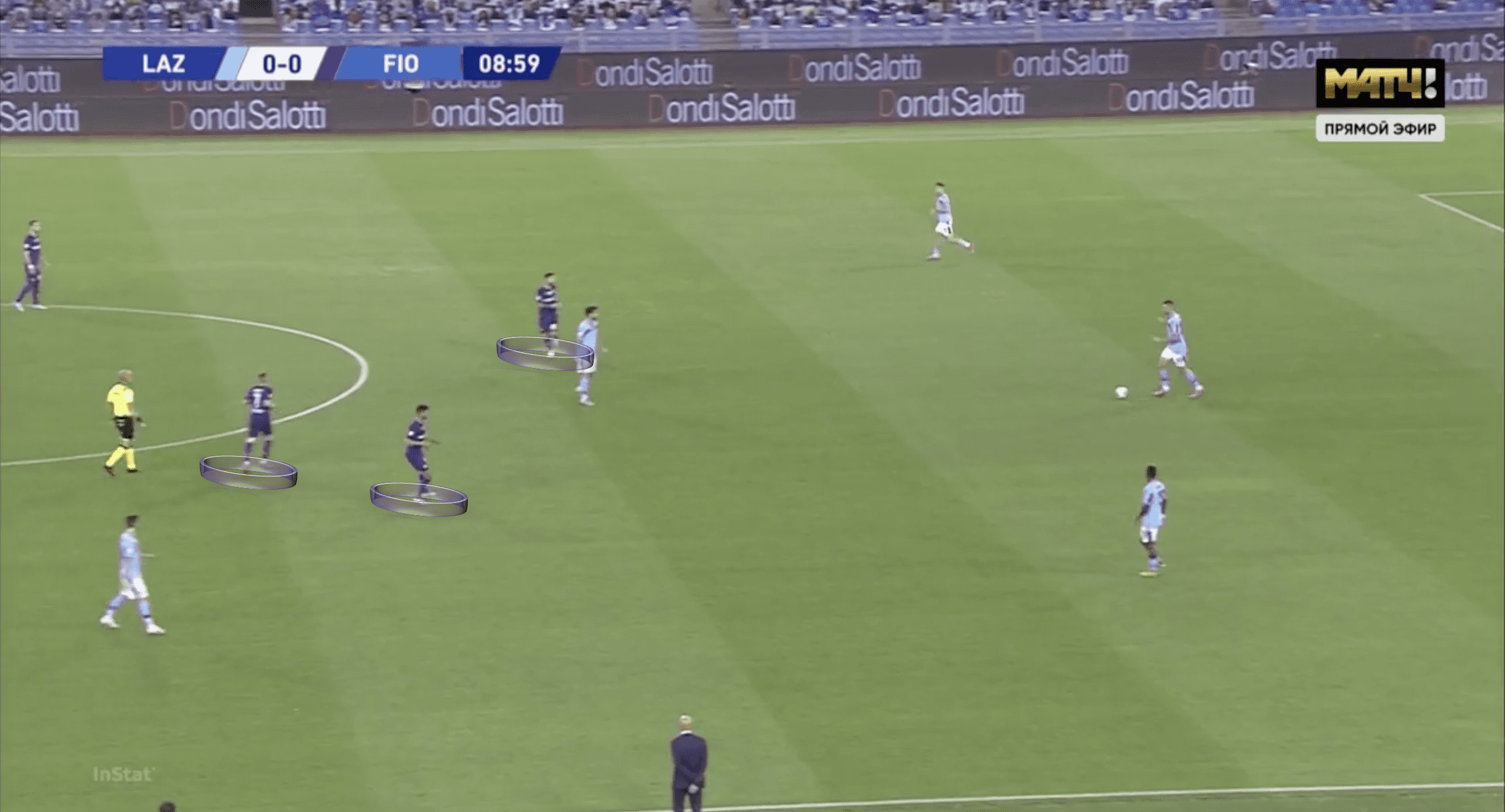
In this image, you can see the intent from Fiorentina to keep their first line of pressure narrow and away from the influential midfield of Lazio. You will also notice, in line with the wingback theme that neither Lazio wingback is in the picture here and therefore in the early exchanges, Lazio struggled to progress the ball forwards and were caught on a couple of occasions trying to play centrally into an overload against Fiorentina’s box midfield.
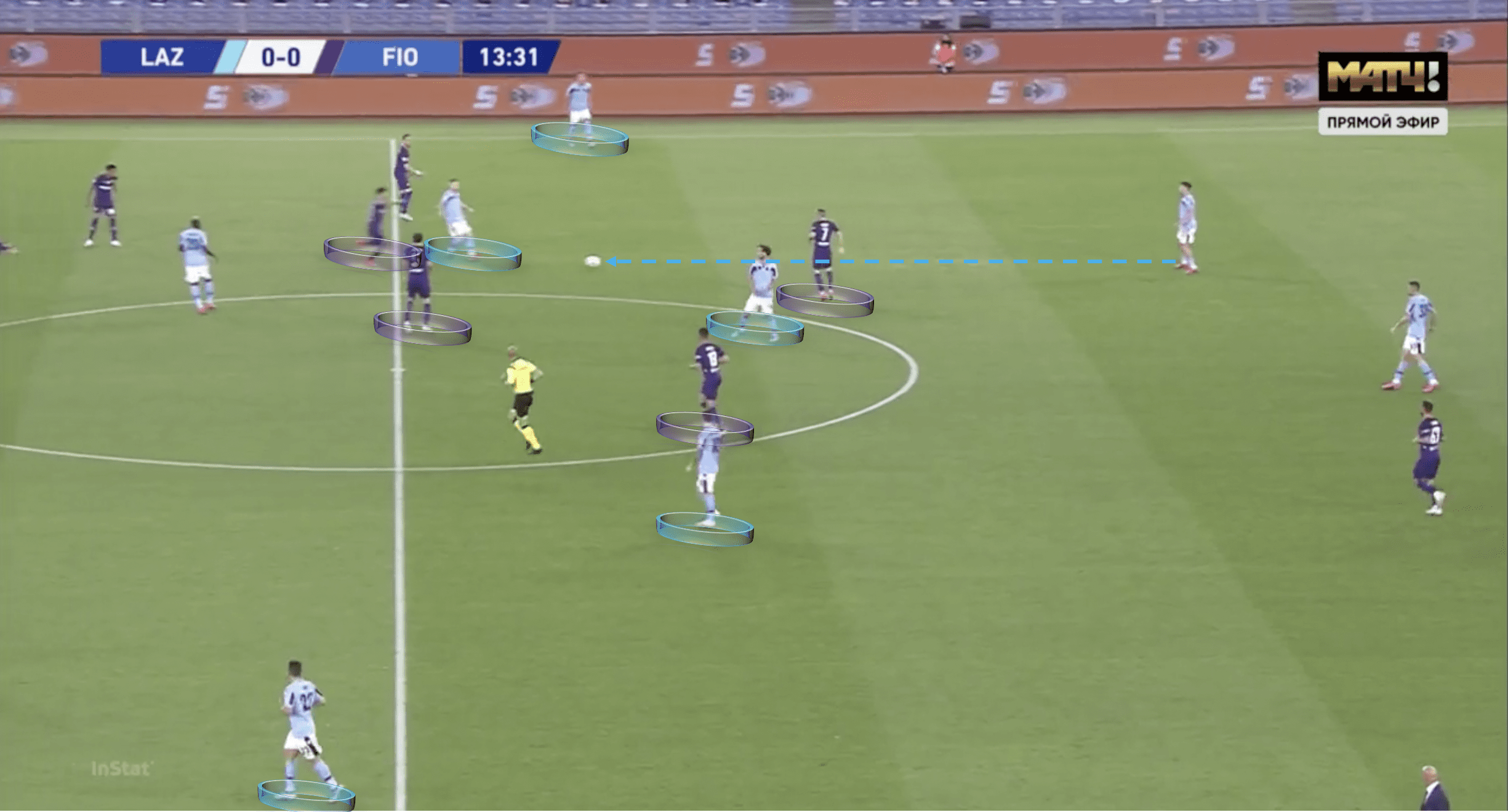
Here is an example of Lazio’s early issues. While the wingbacks have flattened off now, because of their high starting positions they have been absorbed by the Fiorentina block. This allows the Lazio back-three to bring the ball out without pressure but creates chances in this area of the pitch for turnovers and quick counters.
Notice the narrowness of the front three again and the limited space between lines because of the height of the backline due to a lack of Lazio threat in behind, which allows Fiorentina to squeeze up the pitch. This moment is essentially a 4v2 for Fiorentina to recover and counter as the ball into Milinkovic-Savic is a pressing opportunity and they play quickly forward into the waiting Ribery.
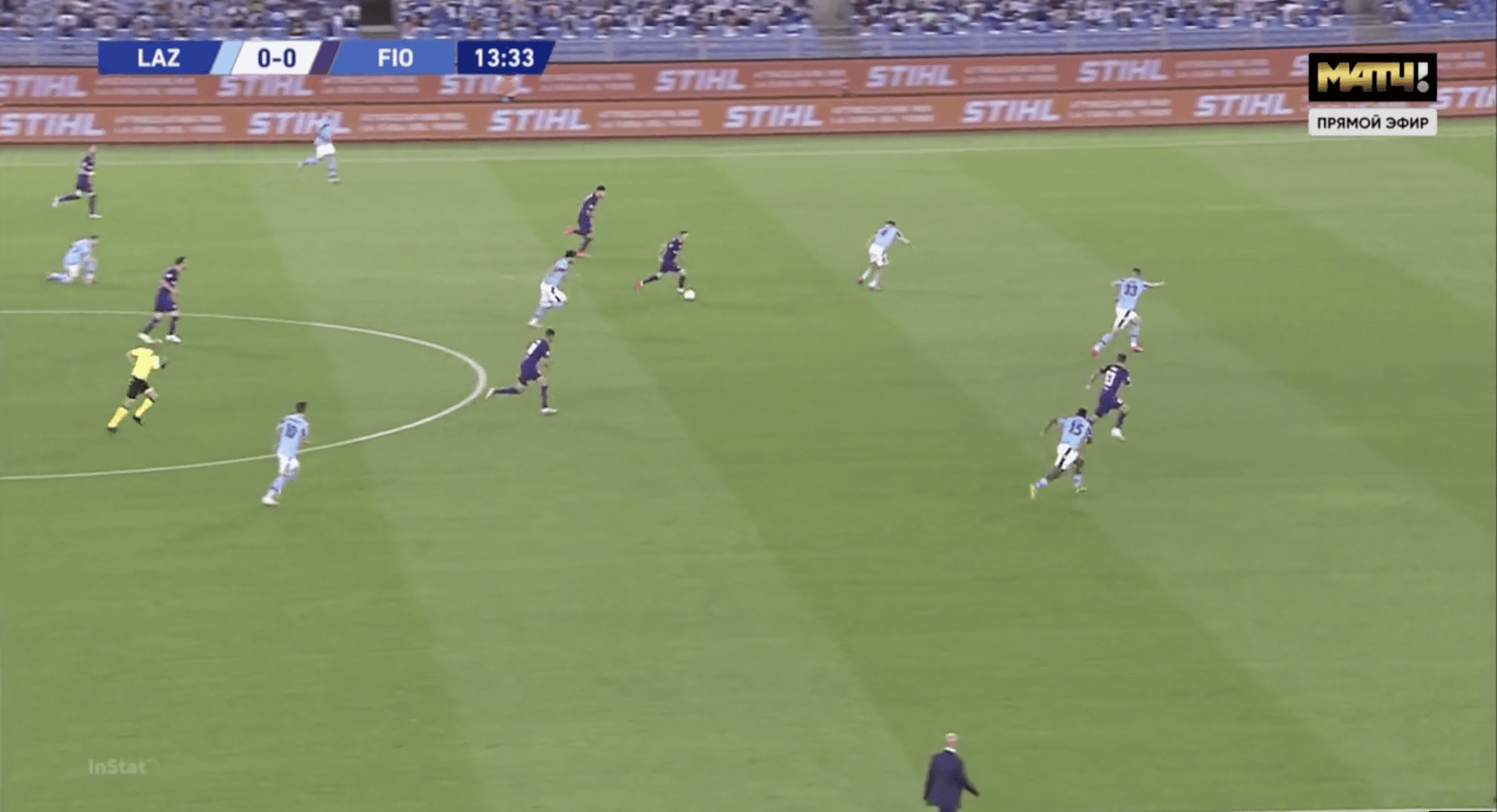
Here is the consequence of the early pressure for Lazio. A fast break against a scrambling back-three is a dangerous moment. Again the Fiorentina ball carrier, Ribery in this moment driving into space to attract pressure and release a free player is a key principle of the Fiorentina attack.
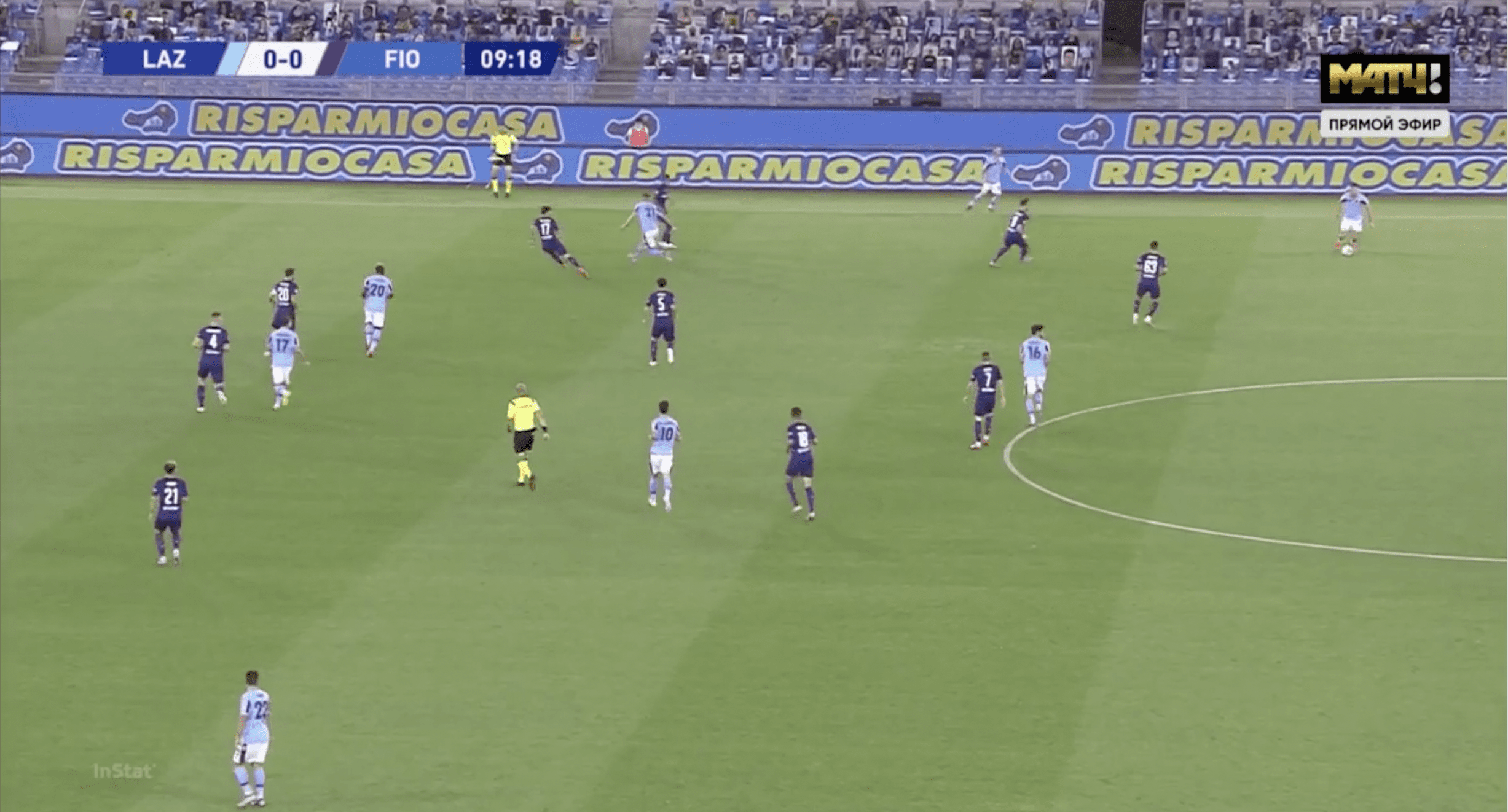
Another example of the Fiorentina block. Limited space in between lines and a difficulty to release the wingback. Fiorentina controlling this area of the pitch and also limiting central progressions of the ball early on in the game.
Lazio though found a clever way around this issue with their tactics as the game progressed.
The following images will give some examples of how their use of the back-three and the wingbacks allowed them to overcome the compact, medium block of Fiorentina and begin getting a grip of the game.
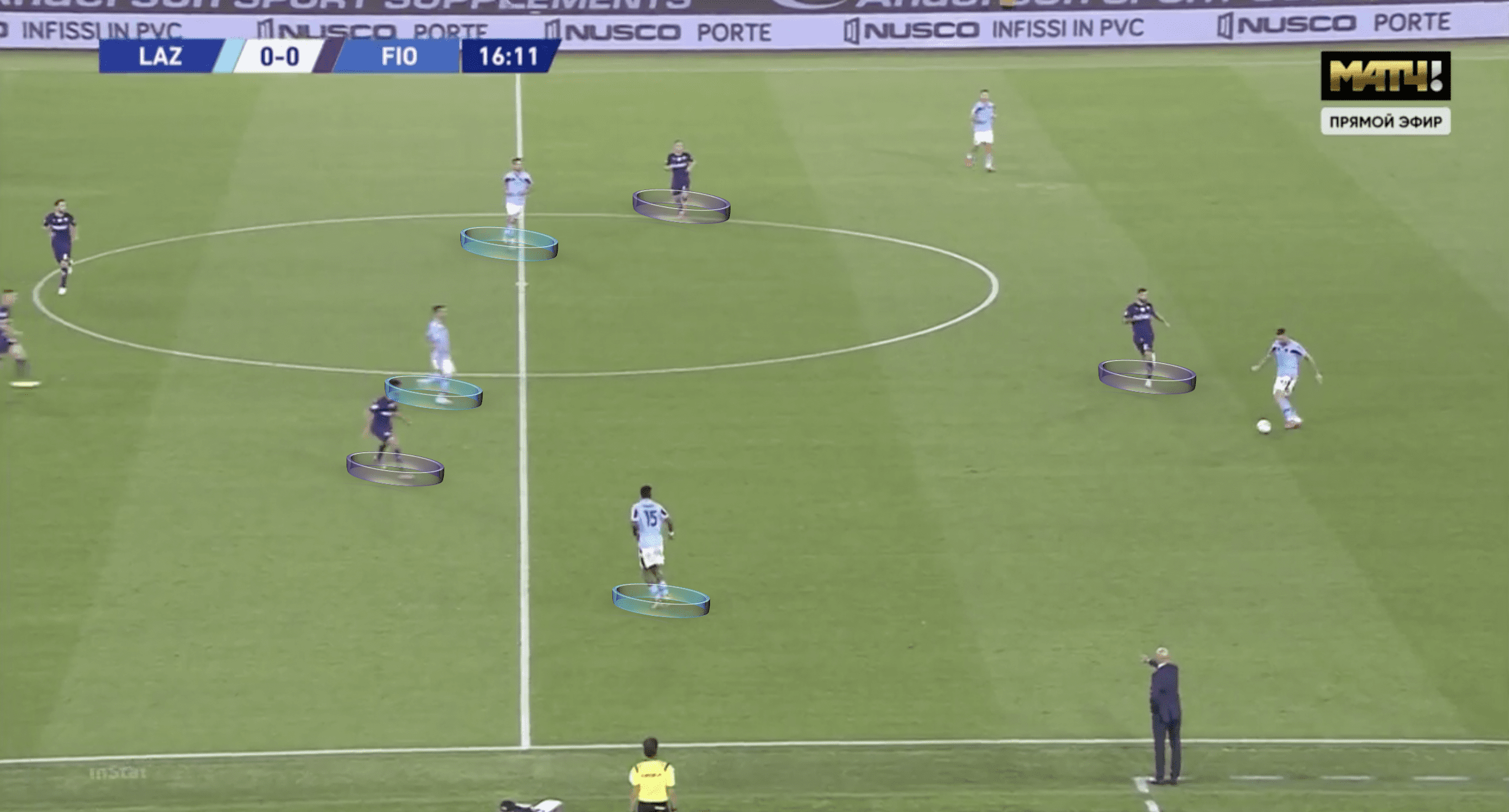
Here is an early example of the change from Lazio. Notice the left centre-back Bastos now start to move higher and wider. This position starts to give Ghezzal a difficult decision to make. Does he stay inside, as obviously instructed and protect passing lines into Alberto or now deal with the ball around him. He chooses the Bastos option and this opens up the pass into Alberto’s feet.
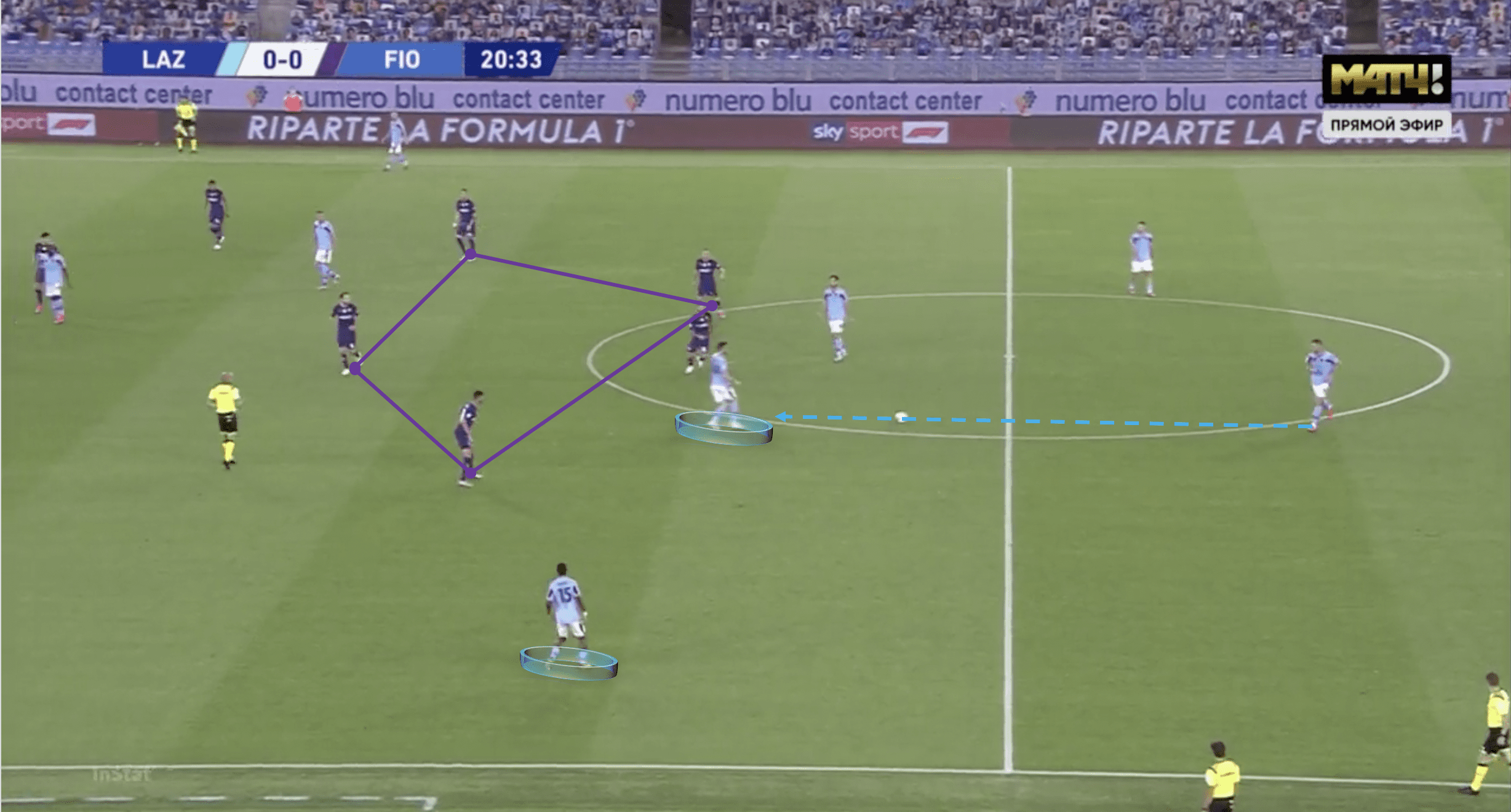
Here, another example. Still compact as a box in midfield, the ball is played into Alberto under the pressure to try and attract a defender. The difference now – Bastos position on the ball side is like a wingback and therefore dangerous to Fiorentina as Lazio can now go around the pressure rather than through.
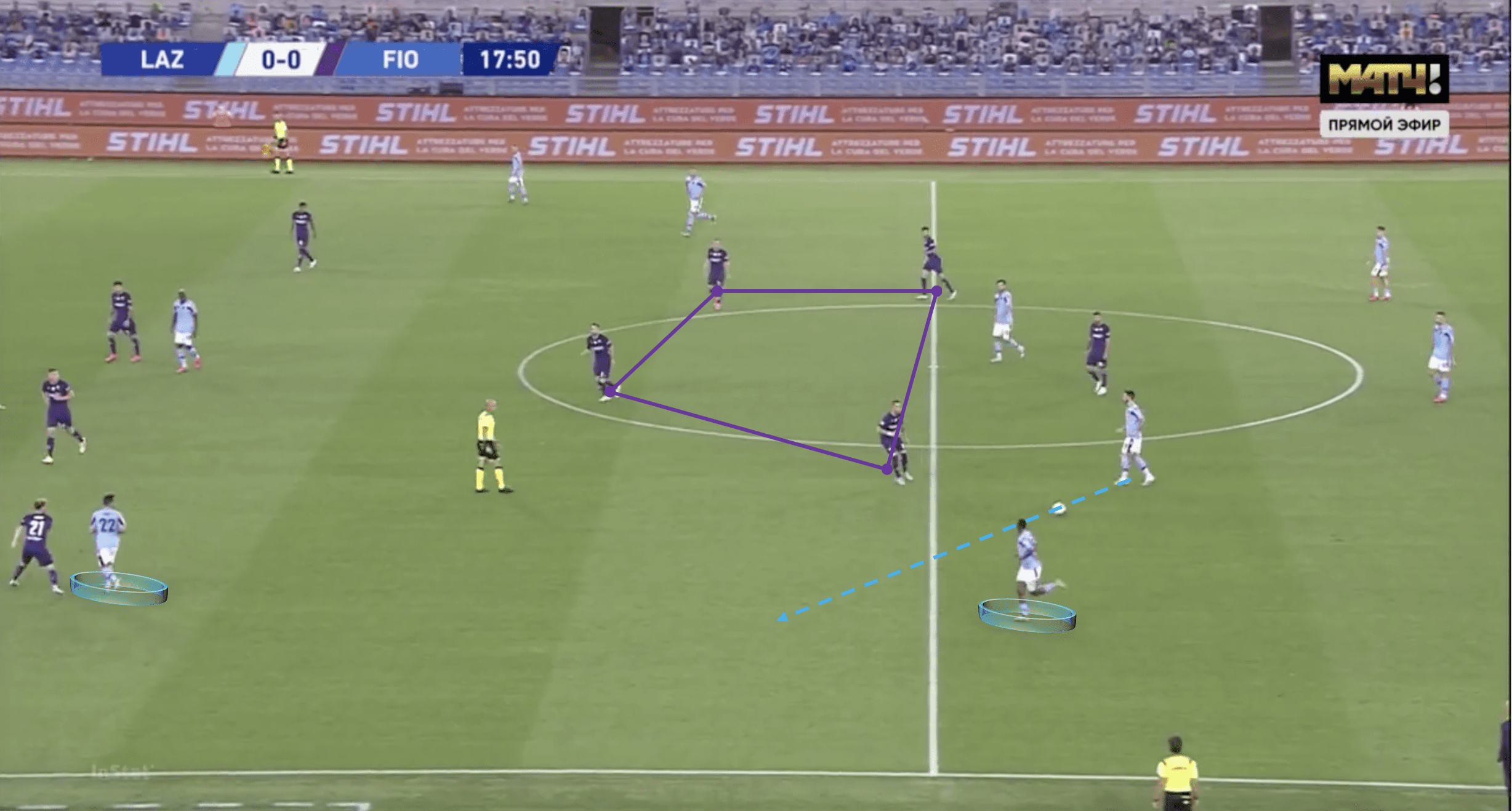
With Luis Alberto now starting to dominate, it gives Bastos even more security to push higher up the pitch for Lazio. That means the wingback, Jony moves inside to create an extra forward against the Fiorentina backline and gives the wingback a difficult decision. If he stays in the line it allows Bastos to carry the ball forwards into space and find a potential overload. If he presses the ball it creates a space in behind him that can now be exploited by Jony or someone in the topline.
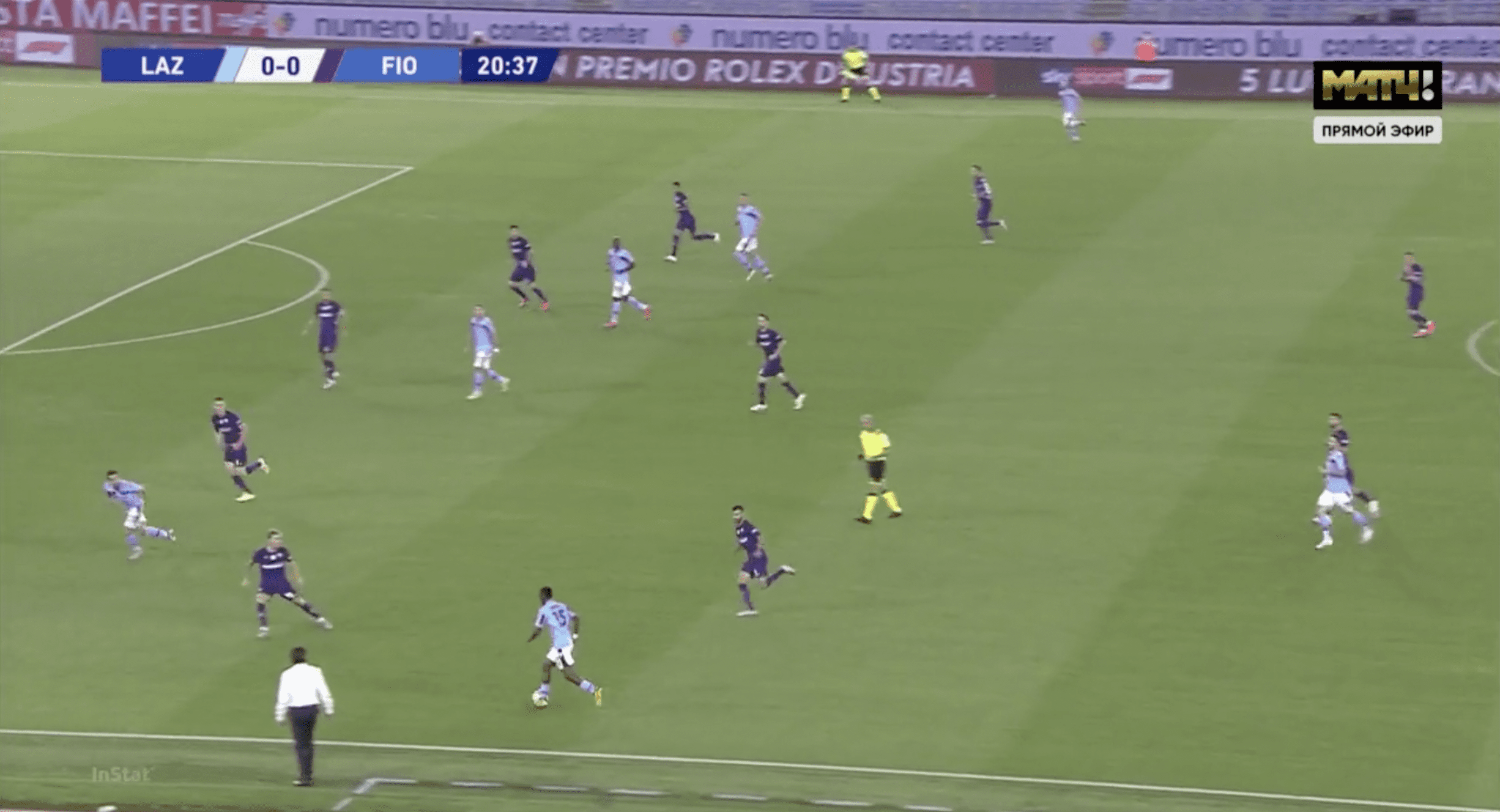
Here you can see the issue unfold. Bastos higher up the pitch, chased by Ghezzal, the #10 but also pressured by the wingback. Notice Jony’s position is now inside but making a run into the space vacated by the wingback. The big key here is that this run isn’t made by a forward, if Jony’s run is tracked by the centre-back on the ball side. Then Lazio have a 3v3 inside the box for a potential cross into the box.
This process in isolation causes Fiorentina to have to defend differently. Because of the lack of pressure at the top Lazio can release one centre-back as a wingback which flattens the Fiorentina box into a flat four. This allows Alberto to drop in to receive and dictate or receive between the lines. Ultimately it creates the platform for him to score the winner as we will see now.
The winning goal
Bastos was replaced at half-time by Stefan Radu who continued on with the good work progressing the ball forwards or opening up pockets for Luis Alberto.
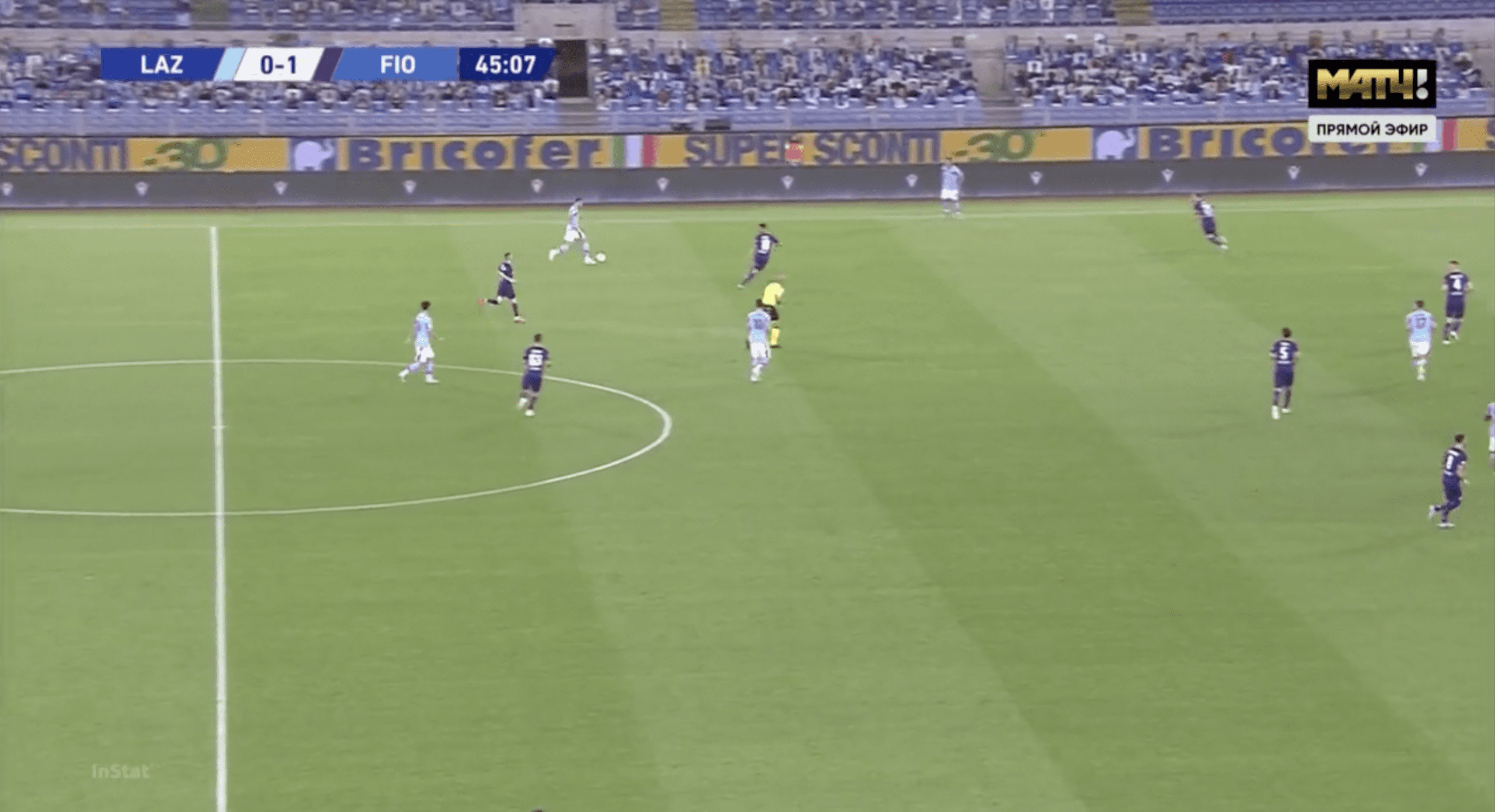
Here we see, straight away in the second half more of the same from Radu as he drives with the ball around the Fiorentina box-midfield and combining with the wingback. Because of this continuation, Alberto’s influence on the game grew as the minutes ticked by. Inzaghi’s flexibility to allow him to dominate from wherever he sees fit gives him the freedom to roam the pitch finding pockets of space to receive and cause problems for the opponent.
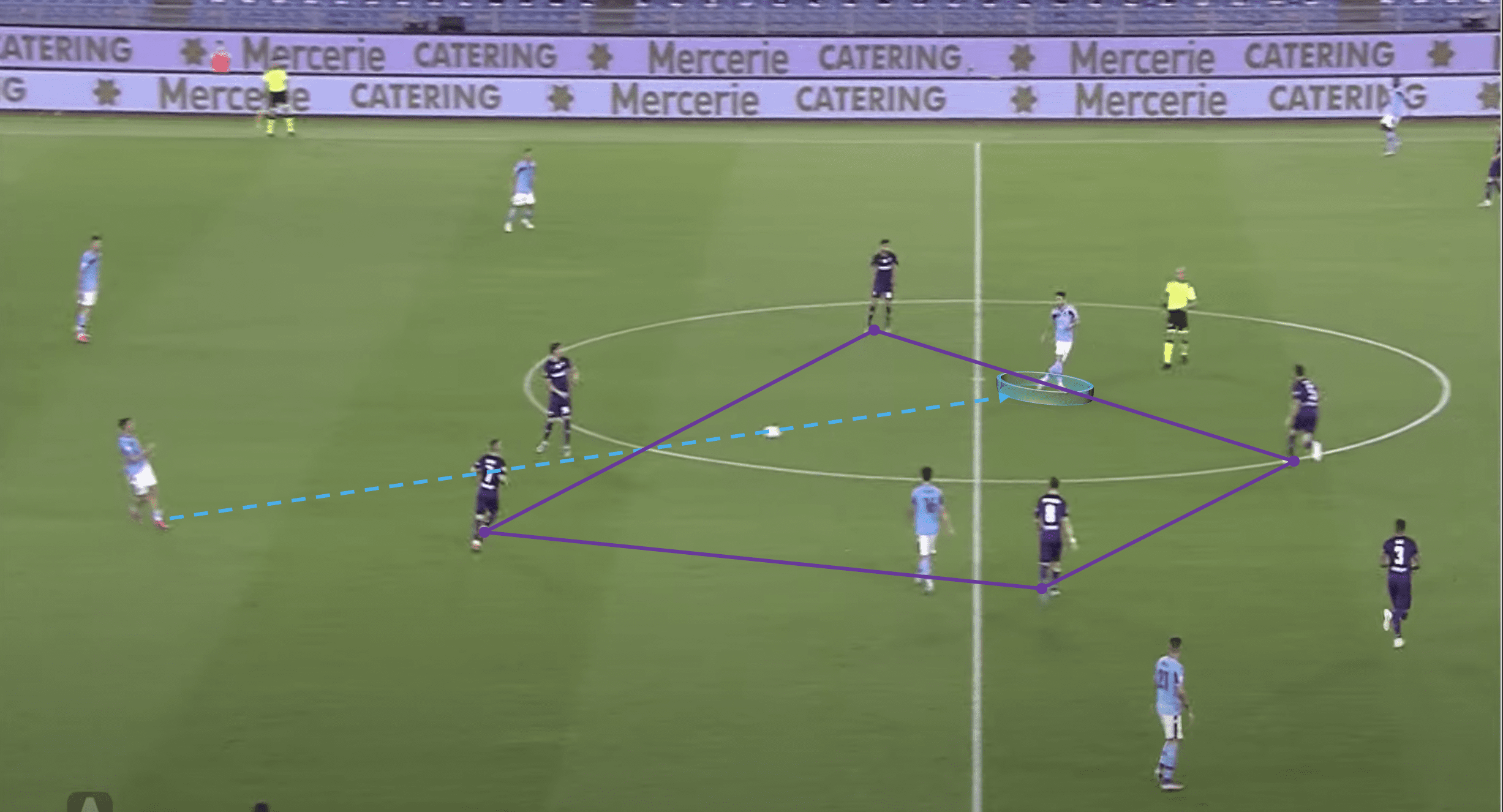
Another perfect example of the earlier tactics around the wingbacks. This time because of the threat of Radu breaking beyond the Fiorentina box the #10’s split slightly allowing this reverse pass to find Alberto in a pocket of space and attracting multiple defenders. Notice on the weak side, the position of the Lazio wingback, high and wide pinning in the backline, and limiting pressure on Alberto if he can turn with the backline stretched across the pitch.
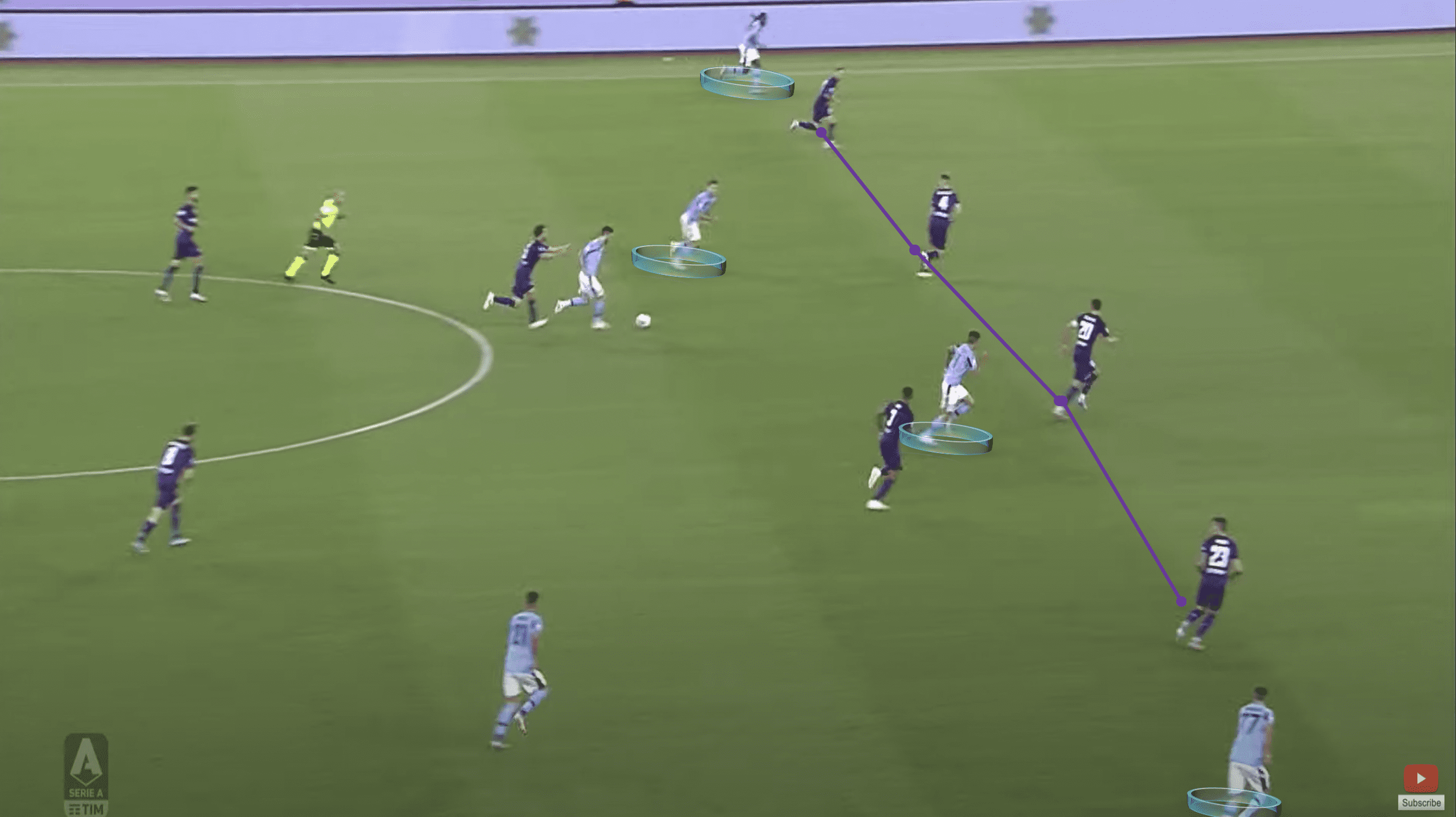
As he receives to face forwards into the space and beyond the base of the Fiorentina box he creates this picture, a difficult moment for the Fiorentina backline to deal with. Runners beyond the ball and time and space to travel into. He could find three forward passes to get his team in behind or he could keep travelling with the ball into the space. He decides to travel a little further before trying to find the league’s top scorer with a pass in behind. He gets lucky that the ball is cut-out but this creates a one-two for him to keep moving forwards before finishing low and hard at the near post. A worthy winning goal in a game scattered with long shots and set pieces as the main chances.
Conclusion
As always Serie A creates such interesting tactical match-ups with high-quality managers finding ways to cause their opposite number issues to force the result in their favor and this game was no different.
Inzaghi’s use of the advanced centre-back was a catalyst and the platform for his system to free up Luis Alberto and Milinkovic-Savic to create Fiorentina problems. Fiorentina did a good job in limiting these moments as the midfield three combined only made 157 passes Fiorentina worked hard to create space for Ribery and Ghezzal to operate with the ball and both teams were successful in doing so for their respective goals. Whether the penalty was or wasn’t and whether VAR should have intervened is for the opinion pieces and the armchairs. Ultimately this was an interesting game that hinged on how well each team succeeded in their tactical objectives and when it really mattered Lazio came out on top. That is why they continue to push Juventus all the way to the end and why Fiorentina are where they are.
Lazio now travel to Torino where they will surely pick up another three points against a side, who despite ending an eight-game losing streak are sinking quickly before they face a slightly more tricky encounter back at home against AC Milan. Fiorentina have a day extra break when they take on Sassuolo in a game they will target for some points as they look to distance themselves from the fire of the relegation battle burning below them.





Comments